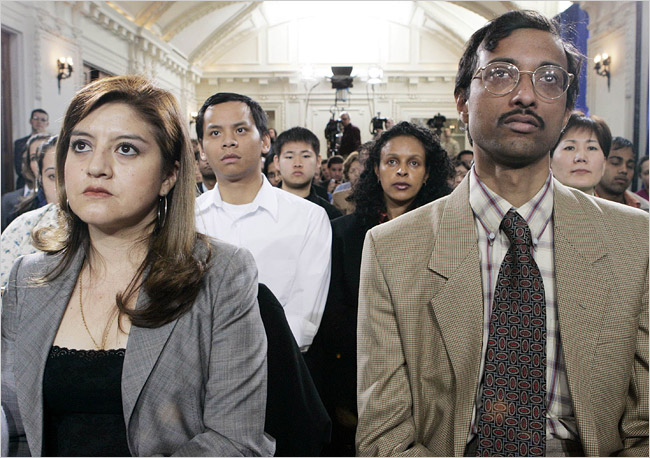| Want to send this page or a link to a friend? Click on mail at the top of this window. |
More Special Reports |
| Posted May 6, 2006 |
| The Other Immigration Highly skilled migrants are much in demand. Why aren't they always welcome? By Christopher Caldwell |
 |
Photograph by Larry Downing |
If you were to set out to design a story that would inflame populist rage, it might involve immigrants from poor countries, living in the United States without permission to work, hiring powerful Washington lobbyists to press their case. In late April, The Washington Post reported just such a development. The immigrants in question were highly skilled — the programmers and doctors and investment analysts that American business seeks out through so-called H-1B visas, and who are eligible for tens of thousands of "green cards," or permanent work permits, each year. But bureaucracy and an affirmative-action-style system of national-origin quotas have created a mess. India and China account for almost 40 percent of the world's population, yet neither can claim much more than 7 percent of the green cards. Hence a half-million-person backlog and a new political pressure group, which calls itself Immigration Voice.
The group's efforts will be a test of the commonly expressed view that Americans are not opposed to immigration, only to illegal immigration. Immigration Voice represents the kind of immigrants whose economic contributions are obvious. It is not a coincidence that the land of the H-1B is also the land of the iPod. Such immigrants are not "cutting in line" — they're petitioning for pre-job documentation, not for post-job amnesty. And people who have undergone 18 years of schooling to learn how to manipulate advanced technology come pre-Americanized, in a way that agricultural workers may not.
But Immigration Voice could still wind up crying in the wilderness. As the Boston College political scientist Peter Skerry has noted, many of the things that bug people about undocumented workers are also true of documented ones. Legal immigrants, too, increase crowding, compete for jobs and government services and create an atmosphere of transience and disruption. Indeed, it may be harder for foreign-born engineers to win the same grip on the sympathies of native-born Americans that undocumented farm laborers and political refugees have. Skilled immigrants can't be understood through the usual paradigms of victimhood.
The economists Philip Martin, Manolo Abella and Christiane Kuptsch noted in a recent book, "As a general rule, the more difficult it is to migrate from one country to another, the higher the percentage of professionals among the migrants from that country." Often this means that the more "backward" the country, the more "sophisticated" the immigrants it supplies. Sixty percent of the Egyptians, Ghanaians and South Africans in the U.S. — and 75 percent of Indians — have more than 13 years of schooling. Their home countries are not educational powerhouses, yet as individuals, they are more highly educated than a great many of the Americans they live among. (This poses an interesting problem for Immigration Voice, which polices its Web forums for condescending remarks toward manual laborers.)
So how are we supposed to address the special needs of this class of migrant? For the most part, we don't. The differences between skilled and unskilled immigrants are important, but that doesn't mean that they are always readily comprehensible either to politicians or to public opinion. When high-skilled immigrants who are already like us show themselves willing to become even more so, jumping every hoop to join us on a legal footing, it dissolves a lot of resistance. But it doesn't dissolve everything. It doesn't dissolve our sense that people like them are different and potentially even threatening.
If we consider our own internal migration of recent decades, this will not surprise us. You would have expected that big movements of people between states — particularly from the North to the Sun Belt and from Pacific Coast cities to Rocky Mountain towns — would cause increasing uniformity and unanimity. But that didn't happen. Instead, this big migration has coincided with the much harped-on polarization between "red" and "blue" America.
Georgians take up jobs on Wall Street and New Englanders unload their U-Hauls in Texas. The sky doesn't fall — but neither do cultural or political tensions between respective regions of the country. Consider the diatribes that followed the last election, in which "red" America stood accused of everything from ignorance and bloodlust to knee-jerk conformity. Or consider North Carolina. As the state filled up with new arrivals from such liberal states as New York and New Jersey, political pundits predicted the demise of its longtime ultraconservative senator Jesse Helms. But Helms won elections until he retired in 2002, largely because many of those transplants voted for him enthusiastically. The sort of Yankees who moved to North Carolina had little trouble adopting the political outlook of their new neighbors. But you didn't notice North Carolinians begging for more of them.
While Immigration Voice looks like an immigrant movement that Americans can rally behind, its prospects are mixed. A recent measure sponsored by Senator Arlen Specter of Pennsylvania to nearly double the number of H-1B visas was passed through committee, then killed and then revived. The fate of skilled immigrants hinges on public opinion, and that is hard to gauge. Even an employer delighted to sponsor an H-1B immigrant for a green card might have no particular political commitment to defending the program, or to wringing inefficiencies out of it. The arrival of skilled individuals arguably makes America a more American place. But not necessarily a more welcoming one. Christopher Caldwell is a contributing writer for the magazine.
Copyright 2006 The New York Times Company. Reprinted from The New York Times Magazine of Sunday, May 6, 2006.
| Wehaitians.com, the scholarly journal of democracy and human rights |
| More from wehaitians.com |